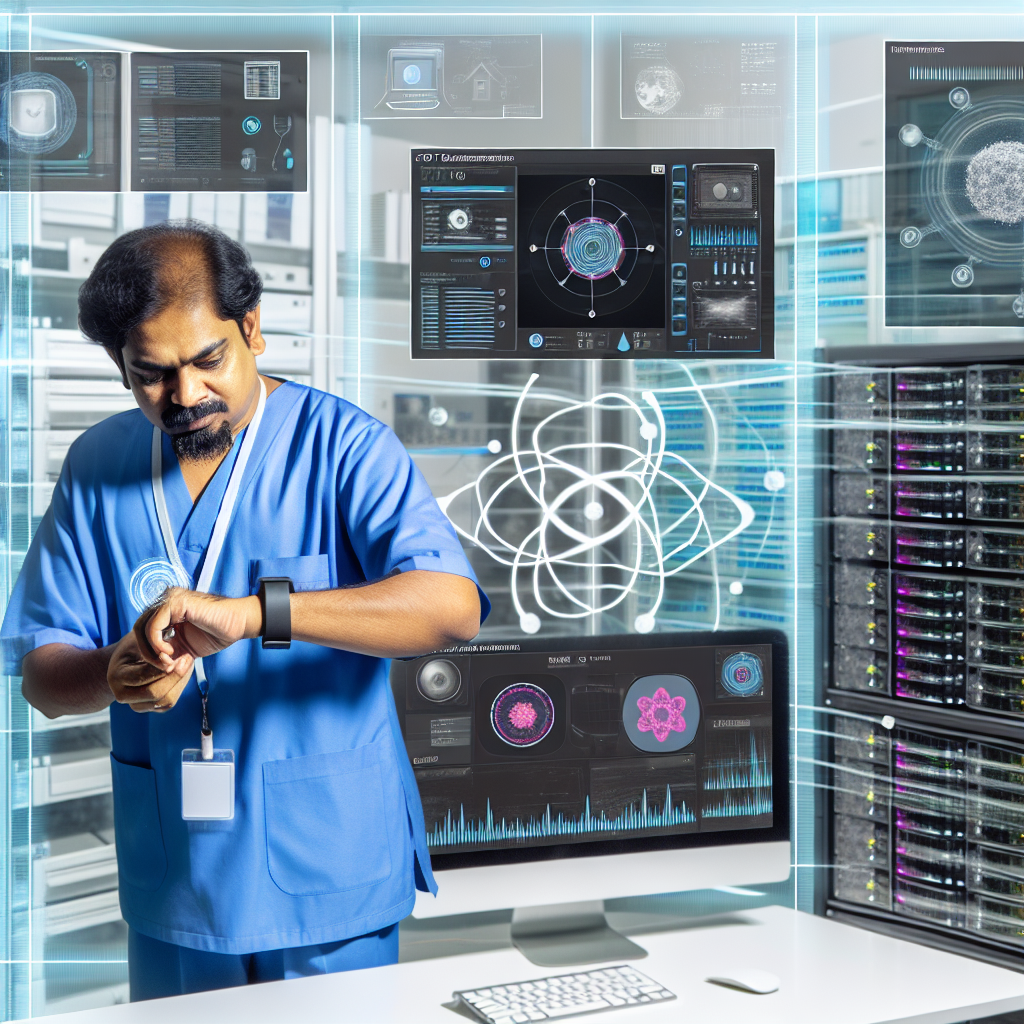Introduction
Overview of the importance of early disease detection in healthcare
Early disease detection plays a crucial role in improving patient outcomes in healthcare.
Timely diagnosis often leads to better treatment options and reduces healthcare costs.
It empowers healthcare providers to implement preventive measures effectively.
Consequently, early detection can significantly lower morbidity and mortality rates.
Traditional methods of disease detection rely on clinical assessments and imaging techniques, but these methods can be time-consuming and prone to human error.
In this context, artificial intelligence (AI) algorithms have begun transforming disease detection.
They analyze vast amounts of medical data rapidly and accurately.
These algorithms can unearth patterns in data that may escape even experienced clinicians.
Brief discussion of how AI algorithms are transforming disease detection
AI algorithms utilize machine learning and deep learning techniques to enhance diagnostic precision.
Machine learning algorithms learn from historical health data, identifying trends associated with various diseases.
Deep learning algorithms work on the principles of neural networks, processing images and signals to detect abnormalities.
As a result, AI reduces the time taken to diagnose conditions like cancer, diabetes, and heart disease.
Purpose of the blog to explore various AI algorithms used in healthcare
This blog aims to delve into the various AI algorithms used in healthcare for early disease detection.
We will explore how algorithms like support vector machines, decision trees, and convolutional neural networks operate.
Additionally, we will discuss the benefits and challenges of implementing these technologies in clinical settings.
The integration of AI algorithms into healthcare is promising but not without challenges.
Concerns about data privacy, algorithm bias, and the need for transparency persist.
Despite these hurdles, the momentum for AI-driven solutions continues to grow.
Both healthcare providers and patients stand to gain from these advancements.
Stay tuned as we examine the potential of AI algorithms to revolutionize early disease detection and improve patient care quality.
Understanding AI Algorithms
Artificial Intelligence (AI) algorithms revolutionize healthcare.
In this context, AI algorithms analyze vast amounts of data to identify patterns.
These patterns help in predicting early stages of diseases.
Healthcare practitioners can thus respond timely and effectively.
Definition of AI Algorithms in the Context of Healthcare
AI algorithms refer to computational models that learn from data.
These models recognize trends within patient data, lab results, and medical histories.
Healthcare professionals use these insights to inform diagnosis and treatment plans.
Here are key characteristics of AI algorithms in healthcare:
- Data-Driven: AI algorithms process and learn from large datasets.
- Adaptive: They improve as they gather more data.
- Predictive: AI algorithms can forecast potential health outcomes.
- Automated: They automate repetitive tasks, reducing human error.
Distinction Between Traditional Methods and AI-Driven Approaches
Traditional healthcare methods rely heavily on human expertise.
Doctors interpret data based on their knowledge and experience.
However, this approach has limitations:
- Subjectivity: Traditional methods may be influenced by personal biases.
- Time-Consuming: Evaluating patient data often requires significant time and effort.
- Limited Data Processing: Humans struggle to analyze large datasets effectively.
In contrast, AI-driven approaches provide clear advantages:
- Data Analysis: AI can process sprawling datasets quickly and accurately.
- Consistency: AI algorithms apply the same logic uniformly, eliminating bias.
- Early Detection: AI can identify anomalies that a human might miss.
Overview of Machine Learning and Deep Learning Concepts
Machine learning (ML) and deep learning (DL) are integral components of AI algorithms.
Both fields enhance disease detection capabilities tremendously.
Machine Learning
Machine learning is a subset of AI focused on building systems that learn from data.
Put Your Tech Company on the Map!
Get featured on Nicholas Idoko’s Blog for just $50. Showcase your business, boost credibility, and reach a growing audience eager for tech solutions.
Publish NowIt employs various techniques, enabling algorithms to recognize patterns.
Key types include:
- Supervised Learning: The algorithm trains on labeled datasets to make predictions.
- Unsupervised Learning: Here, the algorithm identifies patterns without pre-existing labels.
- Reinforcement Learning: The algorithm learns through trial and error, optimizing its outcomes.
In healthcare, supervised learning often plays a crucial role.
Medical images, test results, and patient records serve as labeled datasets.
This learning approach helps predict diseases efficiently.
Deep Learning
Deep learning is a more advanced segment of machine learning.
It utilizes neural networks with multiple layers to analyze data.
Here are its key features:
- Hierarchical Learning: Deep learning models understand data through multiple abstraction levels.
- Feature Extraction: They automatically determine the most relevant features for classification.
- Handling Unstructured Data: Deep learning excels at analyzing images, audio, and text.
In healthcare, deep learning enables the analysis of complex medical images.
It can detect tumors, fractures, and other anomalies in X-rays or MRIs.
Applications of AI Algorithms in Disease Detection
AI algorithms have numerous applications in early disease detection.
These applications showcase the technology’s potential.
- Radiology: AI algorithms analyze medical images to detect abnormalities swiftly.
- Genomics: They identify genetic markers linked to specific diseases.
- Wearable Devices: AI algorithms track health metrics, alerting users to potential issues.
- Electronic Health Records: They analyze patient histories to predict disease risk.
Challenges and Considerations
Despite their advantages, AI algorithms face challenges in healthcare.
Identifying and overcoming these challenges is crucial for success.
- Data Privacy: Safeguarding patient data is paramount to maintain trust.
- Bias in Algorithms: Ensuring equity requires careful consideration of training data.
- Integration with Existing Systems: AI must blend seamlessly with current healthcare infrastructures.
- Regulatory Compliance: Adhering to healthcare regulations is critical for implementation.
Future Directions
The future of AI algorithms in healthcare looks promising.
Continuous advancements will likely enhance their effectiveness.
- Improved Algorithms: Ongoing research will yield more sophisticated models.
- Greater Collaboration: Partnerships between tech companies and healthcare organizations will flourish.
- Real-World Applications: More AI tools will become available to healthcare providers.
- Patient Empowerment: AI makes it easier for patients to engage in their health decisions.
In summary, understanding AI algorithms in healthcare is essential.
AI algorithms enhance early disease detection significantly.
With continuous improvements, the impact of AI in healthcare will only grow stronger.
Read: Predictive Analytics Software for Preventative Healthcare
Types of AI Algorithms Used in Early Disease Detection
Artificial intelligence (AI) plays a significant role in early disease detection in healthcare.
Various algorithms help predict and identify health conditions before they become severe.
This section delves into the three primary types of AI algorithms used for this purpose: supervised learning, unsupervised learning, and deep learning techniques.
Supervised Learning Algorithms
Supervised learning algorithms require labeled data for training.
These algorithms learn from existing data to predict outcomes for new, unseen data.
The healthcare sector benefits greatly from these models.
Below are some common types of supervised learning algorithms:
- Decision Trees: Decision trees model decisions and their possible consequences. They structure data in a tree-like format, splitting it into branches based on decision criteria.
Healthcare professionals use decision trees for diagnosing diseases by creating a series of questions that lead to a diagnosis. - Support Vector Machines (SVM): SVMs are powerful classifiers that find a hyperplane to separate different classes in the data. They perform well in high-dimensional spaces, making them useful for medical data, which often contains numerous features.
Supervised learning provides a robust framework for making predictions in healthcare.
By analyzing labeled datasets, these algorithms enhance diagnostic accuracy and patient outcomes.
They assist healthcare professionals in making informed decisions based on data-driven insights.
Unsupervised Learning Methods
Unsupervised learning algorithms analyze data without labeled outcomes.
These algorithms aim to uncover hidden patterns or groupings within the data.
They are invaluable for understanding complex datasets in healthcare.
Here are some key unsupervised learning methods:
- K-Means Clustering: This method divides a dataset into K clusters based on similarity. Healthcare researchers use K-means to group patients with similar symptoms or treatment responses.
This helps in tailoring personalized treatment plans. - Hierarchical Clustering: Hierarchical clustering builds a tree structure that represents data groupings.
It helps in visualizing the relationships between different patient groups. This technique is useful for identifying sub-populations within larger datasets. - Principal Component Analysis (PCA): PCA reduces the dimensionality of large datasets while preserving variance.
This method simplifies complex healthcare data, making it easier to interpret. It aids researchers in identifying critical features that contribute to disease conditions. - t-Distributed Stochastic Neighbor Embedding (t-SNE): t-SNE visualizes high-dimensional data by creating a two or three-dimensional map.
It helps in exploring and identifying clusters within the data. This technique is particularly useful in genomics and understanding disease biomarkers. - Gaussian Mixture Models (GMM): GMM assumes that data points are generated from a mix of several Gaussian distributions. This method is effective in modeling complex data distributions observed in medical datasets, such as patient responses to varying treatments.
Unsupervised learning enables healthcare professionals to uncover crucial insights from unstructured data.
Put Your Tech Company on the Map!
Get featured on Nicholas Idoko’s Blog for just $50. Showcase your business, boost credibility, and reach a growing audience eager for tech solutions.
Publish NowBy revealing patterns and relationships, these algorithms facilitate better understanding for more effective interventions.
Deep Learning Techniques
Deep learning leverages neural networks to analyze large datasets and improve prediction accuracy.
These techniques simulate human brain functioning, enabling them to learn complex patterns effectively.
Below are some prominent deep learning techniques in healthcare:
- Convolutional Neural Networks (CNN): CNNs excel at analyzing visual data and are widely used in medical imaging. They identify patterns in X-rays, MRIs, and CT scans, assisting radiologists in diagnosing conditions such as tumors or fractures.
- Recurrent Neural Networks (RNN): RNNs process sequential data and are suitable for analyzing time-series data in healthcare. They predict disease progression based on historical patient data. This is beneficial for patients with chronic illnesses requiring continuous monitoring.
- Long Short-Term Memory Networks (LSTM): A specialized type of RNN, LSTMs are adept at remembering long-term dependencies. They use this capability to forecast patient outcomes over extended periods. This is particularly relevant in chronic disease management.
- Autoencoders: Autoencoders learn efficient representations of data by compressing and reconstructing it. They are useful in feature reduction and anomaly detection in healthcare data. This method aids in identifying unusual patterns that may indicate health issues.
- Generative Adversarial Networks (GANs): GANs consist of two competing neural networks that generate new data instances. They are instrumental in augmenting medical datasets, especially when data is scarce. GANs help in enhancing the training of other models, enabling better predictions of disease outcomes.
Deep learning techniques empower healthcare systems by providing advanced analytical capabilities.
These algorithms facilitate early diagnosis and improve treatment plans, ultimately enhancing patient outcomes.
In essence, various AI algorithms, from supervised to unsupervised learning and deep learning techniques, drive innovation in early disease detection.
Each algorithm plays a unique role in analyzing healthcare data, leading to more accurate diagnoses and timely interventions.
As AI continues to advance, its integration into healthcare will undoubtedly revolutionize patient care and medical research.
Read: Wearable Tech Software for Chronic Disease Management
Real-World Applications of AI Algorithms in Healthcare
Artificial intelligence (AI) technologies have revolutionized the healthcare sector, especially in early disease detection.
As healthcare professionals strive for timely interventions, AI algorithms provide the necessary tools to analyze medical data.
This section highlights several key case studies, discusses advancements in medical imaging, and explores the integration of wearable health technologies.
Successful Case Studies in Early Disease Detection
Numerous case studies demonstrate the effectiveness of AI algorithms in identifying diseases early.
These projects highlight the potential of AI in improving patient outcomes.
The following examples showcase AI’s role in detecting various health conditions:
- Cancer Detection: Numerous studies harness AI for early cancer diagnosis. For instance, Google’s DeepMind developed an algorithm that analyzes mammograms.
Clinical trials show that this algorithm outperformed radiologists in detecting breast cancer. It successfully reduced false positives and false negatives, paving the way for better patient outcomes. - Diabetes Prediction: AI algorithms also aid in predicting diabetes. Researchers at Stanford University created a machine learning model that analyzed electronic health records (EHRs).
This model accurately predicted the onset of type 2 diabetes three to five years in advance. By identifying at-risk individuals, healthcare providers could offer lifestyle interventions early on. - Cardiovascular Disease Risk Assessment: The Framingham Heart Study has been a cornerstone in cardiovascular research. A recent application of AI uses EHR data to enhance risk prediction.
A machine learning algorithm analyzed hundreds of thousands of patient records, identifying high-risk individuals for heart disease. This proactive approach allows for early interventions and improved care planning.
AI in Medical Imaging Analysis
AI algorithms significantly impact imaging modalities such as radiology and pathology.
By analyzing vast amounts of imaging data, these technologies enhance diagnostic accuracy.
Here’s how AI excels in medical image analysis:
- X-ray Analysis: AI systems can assess chest X-rays for signs of pneumonia or tumors. For instance, a deep learning model developed by researchers at Stanford University detected pneumonia with high accuracy. The algorithm reduced diagnostic errors and improved speed, allowing for faster treatment.
- CT and MRI Scans: AI algorithms can analyze CT and MRI images for conditions like brain tumors or fibrosis. Algorithms trained on large imaging datasets can identify abnormalities better than human experts. For example, an AI model used in neurology can detect multiple sclerosis lesions quickly, facilitating timely treatment decisions.
The Role of Wearable Health Tech and Monitoring Systems
Wearable health technologies increasingly incorporate AI algorithms to monitor patient health in real time.
These devices allow patients to take charge of their health.
Here are some examples of how wearables improve early disease detection:
- Smartwatches: Many smartwatches now include features for heart rate monitoring, ECG, and blood oxygen level checks.
Companies like Apple and Fitbit have integrated advanced algorithms that analyze heart rhythm data. This analysis can detect arrhythmias and send alerts for further evaluation. - Continuous Glucose Monitoring (CGM): Patients with diabetes benefit from wearable CGM devices.
These devices continuously track glucose levels, and AI algorithms predict glucose fluctuations. With timely alerts, patients can make informed decisions to prevent complications. - Sleep Trackers: Sleep tracking devices assess sleep patterns and quality. Some advanced devices analyze data to predict sleep apnea episodes. By providing insights into sleep health, these tools encourage individuals to seek medical advice early.
Combining Data Sources for Comprehensive Diagnostics
AI’s true potential lies in its ability to integrate multiple data sources.
By combining imaging, EHRs, and wearable data, healthcare providers gain a holistic view of patient health.
This comprehensive approach allows for more individualized care.
Here’s how combining these data sources works:
- Integrated Patient Profiles: AI algorithms can create detailed profiles for patients. By analyzing EHRs alongside imaging data and wearable metrics, providers can assess overall risk. Tailoring interventions based on comprehensive data enhances preventive care.
- Predictive Analytics: Combining various data sources allows AI models to forecast health events. Algorithms can analyze historical health data, imaging results, and lifestyle factors. This capability promotes proactive health management and timely interventions.
- Remote Patient Monitoring: AI algorithms enhance remote patient monitoring systems. By continuously analyzing data from wearables, these systems flag significant changes in health status. Early alerts enable swift action, reducing the risk of complications.
The Future of AI in Early Disease Detection
The future of AI in healthcare looks promising.
As technology advances, the potential for improved early disease detection continues to expand.
Researchers are exploring several innovative directions:
- Personalized Medicine: AI can help develop personalized treatment plans based on individual risk factors. Tailoring interventions will improve patient experiences and outcomes.
- Enhanced Data Security: As AI systems manage sensitive health data, ensuring security becomes critical. Innovations in blockchain technology may augment data protection.
In general, AI algorithms significantly enhance early disease detection in healthcare.
With successful case studies, advancements in medical imaging, and the integration of wearables, the healthcare landscape is undergoing a transformation.
Ongoing research and development will further solidify AI’s role in improving patient care, ultimately leading to better health outcomes worldwide.
Read: AI Chatbots for Health Advice and Patient Support

Benefits of Using AI Algorithms for Early Detection
Artificial Intelligence (AI) technologies revolutionize various sectors, and healthcare is at the forefront.
Early disease detection plays a pivotal role in improving patient outcomes.
Put Your Tech Company on the Map!
Get featured on Nicholas Idoko’s Blog for just $50. Showcase your business, boost credibility, and reach a growing audience eager for tech solutions.
Publish NowAI algorithms drive significant advancements in this arena.
Let’s explore the benefits of using AI algorithms for early disease detection.
Enhanced Accuracy and Efficiency
One of the primary benefits of AI algorithms is their ability to enhance diagnostic accuracy.
Traditional diagnostic methods, often reliant on human expertise, can introduce errors.
AI algorithms, trained on vast datasets, can analyze medical images, lab results, and patient records with remarkable precision.
For example, a study indicated that AI outperformed trained radiologists in identifying breast cancer in mammograms.
While human experts may miss subtle signs, AI systems leverage deep learning techniques to detect patterns that indicate the early stages of disease.
This significant improvement reduces false positives and negatives, leading to better patient care.
Furthermore, AI algorithms provide efficiency in the diagnostic process.
AI systems can process information rapidly, offering results in real time.
This speed proves invaluable in critical situations, such as emergencies or life-threatening conditions.
Healthcare professionals who utilize AI can make timely decisions, resulting in prompt interventions.
Potential for Personalized Medicine
Another remarkable advantage of AI in early disease detection is its potential for personalized medicine.
Each patient presents unique characteristics, including genetic makeup, medical history, and lifestyle factors.
AI algorithms can analyze these diverse datasets to identify individual risk factors and tailor treatment accordingly.
For instance, machine learning models can predict which patients are more susceptible to certain diseases based on genetic markers.
By reviewing vast amounts of genomic data, AI can help clinicians establish more accurate risk profiles.
This allows for earlier interventions and customized treatment plans that are more likely to succeed.
Additionally, AI’s capacity to streamline clinical trials enhances personalized medicine.
With AI tools, researchers can identify suitable candidates based on specific genetic criteria.
Personalized treatments can thus reach the market faster, positively impacting patient care and treatment outcomes.
Ability to Analyze Large Volumes of Data
The healthcare sector generates an immense amount of data daily.
Hospitals, clinics, and laboratories produce records that contain valuable insights.
However, manually analyzing such large volumes can overwhelm traditional methods.
AI algorithms excel in this regard, quickly sifting through extensive datasets to identify trends and correlations.
Utilizing natural language processing, AI can interpret unstructured data from medical records and clinical notes.
This capability helps healthcare providers gain insight into patient health trends that may not be immediately visible.
Moreover, AI algorithms can integrate disparate data sources, offering a comprehensive view of patient health.
For example, AI applications can analyze social determinants of health, such as housing and education, alongside clinical data.
Understanding these factors aids in identifying populations at risk for specific diseases.
By recognizing these correlations, healthcare systems can implement proactive measures, addressing health disparities early on.
Informed Decision-Making
AI algorithms empower healthcare professionals in making informed decisions.
Through predictive analytics, these tools can assess a patient’s risk of developing a disease.
Clinicians can review risk scores generated by algorithms, facilitating tailored care plans.
This informed approach minimizes reliance solely on intuition or individual experience.
Put Your Tech Company on the Map!
Get featured on Nicholas Idoko’s Blog for just $50. Showcase your business, boost credibility, and reach a growing audience eager for tech solutions.
Publish NowHealthcare providers can combine their expertise with AI-generated insights to improve decision-making.
This collaboration enhances the overall quality of care and leads to improved patient outcomes.
Cost-Effectiveness
Implementing AI algorithms in early disease detection proves to be a cost-effective strategy in healthcare.
Early detection significantly reduces the expenses associated with advanced disease treatment.
When diseases are diagnosed at earlier stages, treatment options become less invasive and more affordable.
Furthermore, AI reduces the burden on healthcare systems by facilitating efficient resource allocation.
By identifying high-risk patients, healthcare providers can focus their efforts on those who need more intensive monitoring.
This targeted approach conserves resources and enhances overall system efficiency.
Integration into Existing Healthcare Systems
AI algorithms can seamlessly integrate into existing healthcare frameworks.
Hospitals and clinics can adopt these technologies without overhauling their current systems.
AI solutions work alongside traditional methods, enhancing diagnostic capabilities while allowing healthcare providers to maintain established workflows.
Additionally, many AI tools offer user-friendly interfaces that facilitate ease of use.
Healthcare professionals may find it easy to adopt these technologies without extensive training.
Such integration promotes widespread AI adoption, ultimately benefiting patients and the healthcare system as a whole.
Continual Learning and Improvement
One of the unique characteristics of AI algorithms is their ability to learn continually.
As more data becomes available, AI systems refine their algorithms and improve their accuracy.
This continuous learning leads to ongoing enhancements in disease detection capabilities.
For instance, AI algorithms used in diagnostic imaging can analyze new images over time.
By learning from previous cases, these systems become increasingly adept at identifying subtle changes that may indicate disease progression.
Ultimately, this continual evolution allows healthcare providers to benefit from cutting-edge advancements continuously.
AI algorithms present numerous benefits for early disease detection in healthcare.
Their enhanced accuracy and efficiency surpass traditional methods, leading to better patient outcomes.
The potential for personalized medicine and advanced predictive analytics offers tailored treatment plans.
Additionally, their ability to analyze large datasets fosters informed decision-making and cost-effectiveness.
As healthcare systems increasingly embrace these advanced technologies, AI’s role will expand.
The integration of AI within existing frameworks ensures these remarkable tools become indispensable to modern healthcare.
By leveraging AI algorithms, healthcare can achieve unprecedented improvements in early disease detection, ultimately benefiting patients and society at large.
Read: Cloud-Based Medical Imaging Software for Diagnostics
Challenges and Limitations of AI in Disease Detection
As the integration of artificial intelligence (AI) in healthcare expands, many opportunities arise for improving disease detection.
However, several challenges and limitations hinder its full potential.
Understanding these issues is crucial for healthcare providers and technology developers alike.
Data Quality and Availability Issues
Data is the backbone of AI algorithms.
AI systems require high-quality, diverse data for training.
However, numerous issues can affect data quality in healthcare. These issues include:
- Incomplete Data: Many healthcare records are missing crucial information. Incomplete datasets lead to inaccurate predictions.
- Data Standardization: Different formats across systems complicate data collection. A lack of standardization can cause significant inconsistencies.
- Data Privacy Regulations: Laws like HIPAA restrict data sharing. These regulations limit the availability of comprehensive datasets needed for training AI models.
- Sampling Bias: Some datasets may not represent the entire population. This bias leads to skewed results and hinders generalizability.
Addressing these data quality issues requires strategic solutions.
Put Your Tech Company on the Map!
Get featured on Nicholas Idoko’s Blog for just $50. Showcase your business, boost credibility, and reach a growing audience eager for tech solutions.
Publish NowHealthcare organizations must invest in systems that promote data uniformity and completeness.
Creating robust frameworks for data sharing while adhering to privacy regulations will enhance the quality of datasets.
Algorithmic Bias and Its Implications
Algorithmic bias poses a significant challenge for AI applications.
Bias can arise from various sources, impacting healthcare outcomes.
Key factors contributing to algorithmic bias include:
- Training Data Composition: Biased training data may lead to biased AI outputs. If historical health records predominantly reflect certain demographics, algorithms will learn from these skewed narratives.
- Feature Selection: The choice of features impacts model performance. Neglecting essential features relevant to minority groups risks discriminatory outcomes.
- Evaluation Metrics: Some metrics may favor specific population groups. Focusing solely on overall accuracy can overshadow inequities in representation.
The implications of algorithmic bias are profound.
Bias can lead to misdiagnosis, inappropriate treatment plans, and overall health disparities.
To mitigate these effects, developers must prioritize inclusive and diverse training datasets.
They must also continuously assess their models for fairness and equity.
Concerns About Interpretability
AI’s complexity can hinder its interpretability.
Healthcare professionals often require clear insights into how AI models reach conclusions.
Concerns regarding interpretability include:
- Black Box Models: Many AI algorithms function as black boxes. They provide outputs without explaining underlying rationale, making it hard for clinicians to trust the results.
- Regulatory Compliance: Healthcare regulations demand transparency in clinical decision-making. AI models that lack interpretability may struggle to meet these requirements.
- Change Resistance: Clinicians may resist adopting AI if they cannot understand its decisions. Trust is critical in the doctor-patient relationship, and unclear AI reasoning may erode that trust.
Tackling interpretability is essential for widespread AI acceptance in healthcare.
Developers must create interpretable models that provide clear reasoning for their decisions.
Enhancing transparency will build trust between healthcare providers and AI systems.
While AI algorithms hold incredible potential for early disease detection, challenges must be addressed.
Focusing on data quality, eliminating algorithmic bias, and improving interpretability are vital steps toward a successful AI healthcare ecosystem.
Stakeholders must collaborate to create reliable, equitable solutions that ultimately benefit all patient populations.
By recognizing and tackling these challenges, healthcare stakeholders can harness AI’s power more effectively.
Doing so will not only enhance disease detection but will also foster trust in AI technologies.
Moving forward, the healthcare industry can significantly improve patient outcomes through thoughtful and responsible AI implementation.
Future Trends in AI for Early Disease Detection
Innovations in AI Technology for Early Disease Detection
The field of artificial intelligence (AI) is undergoing rapid advancements.
Innovations are transforming early disease detection significantly.
Many experts believe that future technology will redefine healthcare diagnostics.
One emerging technology likely to have a tremendous impact is quantum computing.
Quantum computing allows for computation at speeds unachievable by classical computers.
It can process vast datasets more efficiently, which is crucial for analyzing complex medical data.
Additionally, AI algorithms will evolve to become smarter and more adaptable.
Machine learning models are learning from diverse datasets, improving their accuracy continually.
These models will soon be able to predict diseases even before physical symptoms manifest.
Innovative techniques, such as federated learning, could also gain traction.
This method enables AI systems to learn without compromising patient privacy.
By using data from multiple institutions, federated learning allows for broad knowledge enhancement.
Collaborations Between AI Developers and Healthcare Professionals
Collaboration is essential for integrating AI technology into healthcare services effectively.
Partnerships between AI developers and healthcare professionals are becoming more prevalent.
Put Your Tech Company on the Map!
Get featured on Nicholas Idoko’s Blog for just $50. Showcase your business, boost credibility, and reach a growing audience eager for tech solutions.
Publish NowThese collaborations bridge the knowledge gap between technology and medical expertise.
Healthcare professionals provide valuable insights into clinical requirements.
Their insights guide AI developers in tailoring solutions to meet real-world needs.
This symbiotic relationship enhances the relevance and effectiveness of AI tools in disease detection.
Moreover, interdisciplinary teams work together to refine algorithms.
Experts in data science, healthcare, and ethics collaborate to ensure quality.
Such teamwork fosters innovation and enhances the overall efficacy of AI solutions.
Real-world testing is crucial for AI applications in healthcare.
In these collaborative efforts, healthcare professionals help in validating AI tools.
They ensure that the systems perform accurately in clinical settings before widespread implementation.
Regulatory Frameworks and Ethical Considerations
With great advancements come significant ethical considerations.
Regulators must establish frameworks to govern the use of AI in healthcare.
Striking a balance between innovation and patient safety is paramount.
Ethical concerns often center around data privacy and security.
As AI systems rely on patient data, safeguarding this information is critical.
Regulatory agencies must implement strict guidelines to protect sensitive patient information.
Additionally, transparency in AI algorithms is essential.
Healthcare professionals and patients must understand how decisions are made.
Clear explanations of AI processes build trust and confidence in these technologies.
Regulatory frameworks need to address potential biases in AI algorithms.
Ensuring that AI systems are fair and equitable is critical to providing quality healthcare.
Developers must ensure datasets represent diverse populations accurately.
Future Predictions in the AI and Healthcare Landscape
The future of AI in healthcare looks promising yet challenging.
Predictions suggest that AI will play a fundamental role in personalized medicine.
Tailoring treatments to individual patient profiles can improve outcomes significantly.
As technology progresses, early disease detection methods will become more sophisticated.
AI systems will likely analyze genetic, lifestyle, and environmental factors to assess risks.
This holistic approach will enhance accuracy in disease prediction.
Furthermore, telehealth’s growth will intersect with AI innovations.
Remote monitoring and AI-driven diagnostics will change how patients receive care.
Patients will have access to timely interventions without visiting healthcare facilities.
At the same time, we must remain vigilant about regulatory adaptations.
Authorities will need to stay ahead of technological advancements.
Continuous evaluation of AI applications in healthcare will ensure patient safety and efficacy.
The Integration of AI into Lower-Resource Settings
Another emerging trend is integrating AI into lower-resource healthcare settings.
Put Your Tech Company on the Map!
Get featured on Nicholas Idoko’s Blog for just $50. Showcase your business, boost credibility, and reach a growing audience eager for tech solutions.
Publish NowMany developing regions struggle with healthcare accessibility.
AI could bridge gaps in these areas by providing affordable diagnostic solutions.
Mobile health applications powered by AI will become more commonplace.
These tools will facilitate early disease detection in remote areas.
They can help healthcare workers perform basic screenings and make informed decisions.
Moreover, training local professionals to utilize AI tools is essential.
Equipping healthcare workers with knowledge empowers them to serve their communities effectively.
This approach fosters sustainability and enhances healthcare delivery.
AI’s potential in early disease detection is undeniable. Innovations, collaborations, and ethical considerations will shape this evolving landscape.
Looking ahead, the future trends in AI promise remarkable advancements in healthcare.
As technology continues to evolve, healthcare providers must adapt accordingly.
Stakeholders must remain vigilant about addressing ethical concerns and regulatory frameworks.
By doing so, we can harness the full potential of AI in saving lives and improving health outcomes.
Conclusion
Recap of key points discussed regarding AI algorithms and their role in early disease detection
In this discussion, we explored the pivotal role of AI algorithms in early disease detection.
We highlighted various algorithms that analyze patient data to identify patterns and predict diseases.
Machine learning techniques, such as supervised learning and neural networks, excel in this domain.
These algorithms enhance diagnostic accuracy by processing vast amounts of data swiftly.
We also emphasized the significance of data integrity.
High-quality, diverse data sets ensure algorithms develop precise models.
The correct application of AI not only predicts outcomes but also reduces false positives and negatives.
Early detection through AI leads to timely interventions, ultimately saving lives.
Future outlook on the evolving relationship between AI and healthcare
As we look to the future, the relationship between AI and healthcare continues to evolve.
Innovations will enhance integration into clinical practices, making AI tools more accessible to healthcare professionals.
Training medical staff in AI utilization will be crucial for effective deployment.
Future advancements will likely improve algorithm adaptability to various medical conditions and populations.
Moreover, regulatory frameworks will emerge to standardize AI implementations.
These frameworks will ensure ethical use and protect patient privacy.
Collaborations between tech companies and healthcare institutions will drive innovations.
This synergy promises transformative impacts on patient care.
Final thoughts on the potential impact of harnessing AI for better healthcare outcomes
Finally, harnessing AI for healthcare transcends simply improving diagnostic accuracy.
It paves the way for personalized medicine, tailoring treatments to individual patient profiles.
As AI continues to improve, healthcare outcomes will likely become more favorable.
The potential for AI to revolutionize healthcare is immense; it could transform patient experiences and treatment pathways.
In short, embracing AI algorithms in early disease detection represents a significant step forward.
The commitment to leveraging these technologies holds the promise of better health outcomes for patients.
Put Your Tech Company on the Map!
Get featured on Nicholas Idoko’s Blog for just $50. Showcase your business, boost credibility, and reach a growing audience eager for tech solutions.
Publish NowBy combining human expertise with AI capabilities, we can create a more responsive and effective healthcare system.
Before You Go…
Hey, thank you for reading this blog post to the end. I hope it was helpful. Let me tell you a little bit about Nicholas Idoko Technologies.
We help businesses and companies build an online presence by developing web, mobile, desktop, and blockchain applications.
We also help aspiring software developers and programmers learn the skills they need to have a successful career.
Take your first step to becoming a programming expert by joining our Learn To Code academy today!
Be sure to contact us if you need more information or have any questions! We are readily available.
[E-Books for Sale]
1,500 AI Applications for Next-Level Growth: Unleash the Potential for Wealth and Innovation
$5.38 • 1,500 AI Applications • 228 pages
Are you ready to tap into the power of Artificial Intelligence without the tech jargon and endless guesswork? This definitive e-book unlocks 1,500 real-world AI strategies that can help you.
See All 1,500 AI Applications of this E-Book
750 Lucrative Business Ideas: Your Ultimate Guide to Thriving in the U.S. Market
$49 • 750 Business Ideas • 109 pages
Unlock 750 profitable business ideas to transform your future. Discover the ultimate guide for aspiring entrepreneurs today!
See All 750 Business Ideas of this E-Book
500 Cutting-Edge Tech Startup Ideas for 2024 & 2025: Innovate, Create, Dominate
$19.99 • 500 Tech Startup Ideas • 62 pages
You will get inspired with 500 innovative tech startup ideas for 2024 and 2025, complete with concise descriptions to help you kickstart your entrepreneurial journey in AI, Blockchain, IoT, Fintech, and AR/VR.
We Design & Develop Websites, Android & iOS Apps
Looking to transform your digital presence? We specialize in creating stunning websites and powerful mobile apps for Android and iOS. Let us bring your vision to life with innovative, tailored solutions!
Get Started Today




